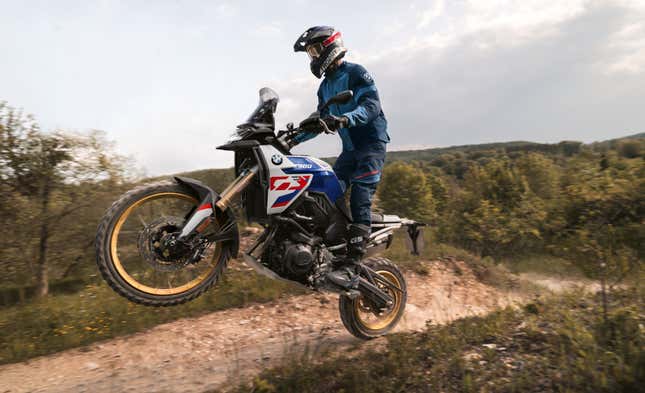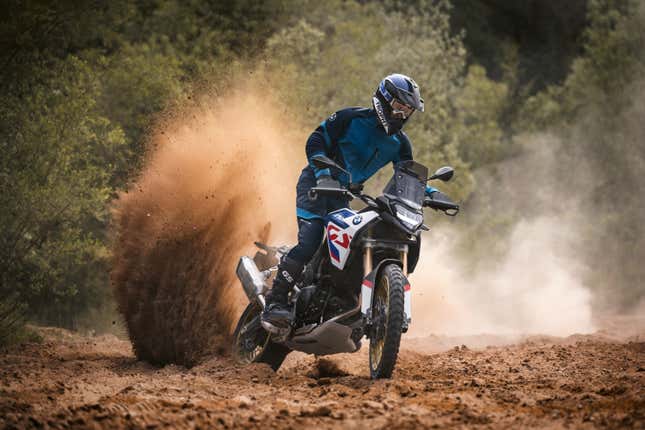2024 BMW F900GS: This Is It

BMW’s midsize adventure bikes are, for my dollar, some of the most fun you can have on two wheels. The punchy twin engines, the tall, narrow frames — I like them so much, I went out and bought one of my own. But the F850GS, like my F800GS before it, has a fatal flaw: It looks kind of dweeby.
Ride Along On The Trans Mass Trail
This is particulalry egregeious when the bike’s competitors — ADVs like the Tenere and Tuareg — just look so damn good. Luckily, BMW’s new update to the middleweight line finally gives up on the beak and asymmetrical headlights, and it creates one of the company’s best-looking bikes in the process. Welcome to the era of the F900GS.
Photo: BMW Motorrad
The F900GS
The new F900GS takes the place of the F850GS as the most middle of the middleweights in BMW’s lineup. We’ll look at its bigger and smaller siblings next, but the biggest design changes in the line come from the 900, most notably the near-total lack of BMW’s signature beak. Instead, the new bike leans into the oh-so-popular Dakar styling, resting just the smallest vestigial point below its symmetrical headlight. It even has a navigation bar — a nice upgrade over prior generations, which forced buyers to step up to the Adventure spec for such luxuries.
Of course, styling isn’t the only difference with the new F900GS. Its displacement is increased from the 850 up to 895 cc, finally bringing horsepower over the three-digit mark to 105 at 8,500 rpm, and the new torque figure of 68.6 pound-feet approaches Ducati DesertX numbers. We’ll need to see the bike in person to know how its claimed 483-pound curb weight, down a claimed 30 pounds from the F850GS, compares to the Ducati’s real-world measured 517-pound mass.

Photo: BMW Motorrad
Like the F850GS, the new 900 uses a steel trellis frame with a bolt-on rear subframe, a favorite of off-roaders who love to bend steel with their biggest BDR crashes. Unlike the outgoing bike, though, the F900GS doesn’t have much else around that subframe. The standard bike sheds all luggage racks in favor of a slimmer, neater rear end with a flat rally-style seat. This is probably ideal news for Me Specifically, a person who wants a big enduro but does too much highway riding to tolerate a buzzy thumper, but it may not be as well-received by fans of hard panniers.
BMW does claim the bike has a new “luggage carrier” that allows you to mount “soft bags, rucksacks or an aluminum case system from the original BMW Motorrad accessories range,” but it’s not clear how that’ll work out for fans of third-party cargo carriers. The F900GS also shares new, updated suspension components with the F900GS Adventure, both using Showa forks up front and a lightened swingarm out back. BMW claims 9.1 inches of clearance up front and 8.5 inches in the rear, as well as seat heights just under 34.5 inches for both.
The F900GS will start at $13,495 before destination fees. If the current F850GS is anything to go by, expect base bikes like that to be rare on dealer lots — you’re likely to shell out another few hundred for an option package along the way, but such fees also net you the sweet São Paulo Yellow color option. It’s a give and take.

Photo: BMW Motorrad
The F900GS Adventure
That shared suspension equipment is as natural a segue as any to the big brother of BMW’s middleweights, the F900GS Adventure. The usual accoutrement that make up the Adventure nameplate are all here — larger fuel tank, bigger windshield, wider foot pegs, aluminum skid plate, extra luggage capacity — but this ADV’s design differs more than usual from its little sibling.
The F900GSA’s design hews much closer to its predecessor, retaining the black-tipped beak and asymmetrical headlights that BMW loved for so long. In fact, many panels on the new bike seem identical to the old one, like the vented beak tip, angular tank pieces, the windshield, and even the luggage rack. Differences between the two may be more apparent when seeing them side-by-side in person, but it seems that adventurers who value that extra fuel capacity will be stuck wearing beaks for a while longer.
The F900GS Adventure starts at $14,195 before destination fees, and like the base F900GS you can expect to pay more from a dealer. I’ve yet to find a Motorrad dealer interested in selling base, stripped-down bikes, but with this generation I’m tempted to look for one.

Photo: BMW Motorrad
The F800GS
Last and (in terms of price and off-road capability) least, we have the F800GS — no, not that F800GS. The nameplate that once stood for the best of BMW’s middleweights is now the entry-level model, and the spec sheet shows it. Despite sharing the F900GS’s displacement, the F800GS makes only 87 hp and 67 lb-ft of torque, which is amusingly still an upgrade from the 85 hp and 59 lb-ft of the last bike to wear the badge.
The F800GS loses suspension travel from its siblings, down to 6.7 inches front and rear, but that leaves the bike with a more approachable 32.1-inch seat height. With the lower clearance and alloy wheels, the F800GS is clearly the on-road option of the three — a nice way to save a few bucks if your adventures largely stick to tarmac.
The F800GS, like the F900GSA, looks much the same as its outgoing predecessor. It retains the beak, the low windshield, and the asymmetrical headlights. But, for that comparatively simpler design refresh, you save a few bucks, as the F800GS starts at $10,495.
As someone who regularly browses Marketplace for Husqvarna 701 Enduros, only to remind myself that I live in Brooklyn, the new F900GS feels like it was targeted very specifically — it’s my hole, it was made for me. I can’t wait to get my hands on one, and see how much has changed from its much-loved predecessors.

Photo: BMW Motorrad



